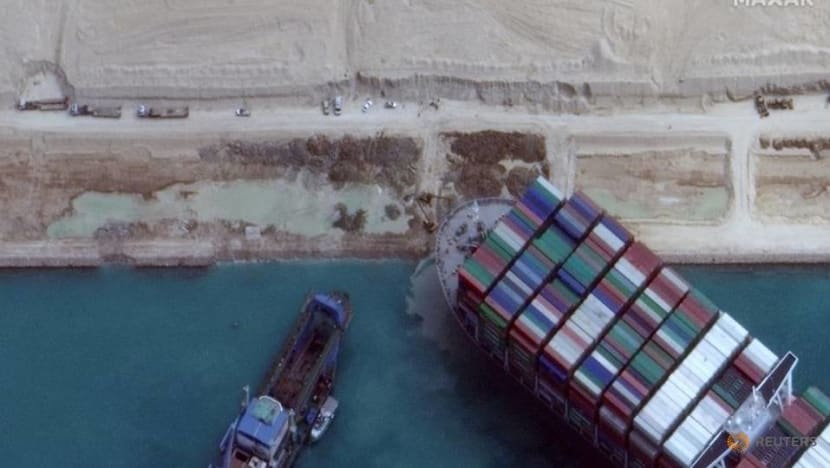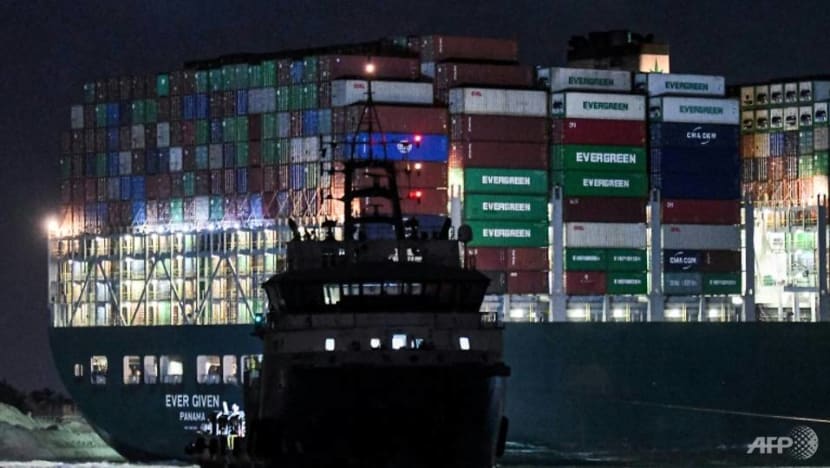commentary Commentary
Commentary: Suez Canal incident reveals why global trade depends heavily on shipping with few alternatives
While the ship in the narrow Suez Canal may be cleared soon, the financial repercussions and serious discussions of alternatives are just beginning, says NUS’ Associate Professor Goh Puay Guan.

A view shows Ever Given container ship in Suez Canal in this Maxar Technologies satellite image taken on March 28, 2021. Maxar Technologies/Handout via REUTERS
SINGAPORE: The Egyptian authorities revealed on Monday (Mar 29) that the traffic through the Suez Canal had resumed after the ship called Ever Given, which had been grounded for almost a week, was refloated.
Although there was general relief about this development, the incident has overall sparked a rethinking about what could have been done to avoid this ugly mess.
Much as businesses hope the episode is an exception, corporate boardrooms all over the world will be tearing apart how things can be done better.
IMPLICATIONS FOR GLOBAL SUPPLY CHAINS
For one, the repercussions on shipments, oil and commodity prices, and availability of goods have been huge. Those in Europe have heard the news that they may face a shortage in instant coffee, as the ingredients could not be shipped over.
Container shipping costs have soared by four times year-on-year, continuing a years-long trend accelerated by COVID-19.
While the ship has been freed and the jam will eventually be alleviated – no matter how long that may take - what are the potential ramifications for global supply chains?
At stake are liabilities for missed deliveries, lost sales, manufacturing down time, expired products, and insurance claims.
READ: Commentary: Too big to sail? Suez Canal debacle sparks debate over huge container ships
This is not only for the Ever Given vessel, but for the delayed deliveries of other affected vessels. Who absorbs these costs will be a lengthy affair of multi-party negotiation among shippers, consignees, shipping lines, freight forwarders, and insurance companies.
The extent of these potential commercial liabilities will increase until the jam of vessels in the waters clears up, considering that billions of dollars of trade passes through the Suez Canal each day.
Countries that have strategic stockpiles can breathe easier. As Transport Minister Ong Ye Kung explained, this is precisely the kind of scenario Singapore has planned drawdown on inventories for.
WHY ALTERNATIVE MODES OF TRANSPORTING GOODS ARE NOT PERFECT
In the short term, shipping routes are still being re-routed, primarily through the Cape of Good Hope in Africa.

This is a longer distance of over 10 days, leading to delays and higher costs. Although the immediate delay is on the Europe-Asia routes, the delays will also affect all other shipping as ship capacity is tied up.
So the question to ask is – will this mean an increase in the use of other transportation modes?
Air freight could be used, although this is more expensive and likely to be activated for urgent shipments, such as out-of-stock raw materials for production, or spare parts for maintenance and repair.
Much depends on where you’re shipping from, the distance, the volume and weight of goods.
A piece of furniture from Shenzhen to the US can cost US$1,200 by ocean but a whopping US$4,000 by air, according to freight management company Freightos.
READ: Commentary: Why the Suez Canal accident is a worst-case scenario for global trade
Air cargo can be used for smaller volume and low weight items, such as e-commerce purchases of consumer items like cosmetics, fashion and electronics, where buyers may be impatient while air freight costs remain low.
But air freight is unlikely to be a large substitute for large shipping by corporations, when such routine replenishment orders planned ahead of time are usually more efficiently transported through seaborne trade.
When businesses don’t use ships, they use overland transport such as rail and trucking.
This had already seen a surge during the pandemic-induced port delays last year, which has fueled the growth of tech integration to ensure seamless connectivity between airports, seaports and last-mile trucking as e-commerce boomed all around the world, allowing businesses to pick and choose routes with the greatest efficiencies.
In part, this explosion of infrastructure has been underway pre-pandemic to serve burgeoning trade between China and the rest of the world.
One example of a rail connection that has seen robust trade is the one that goes from China to Europe, passing through Russia and Central Asia, were introduced in the earlier part of 2010s, and have become part of the Belt and Road Initiative.
Rail and truck shipments from China to Europe have also increased during this period – by almost double according to forwarding group Geodis.

But these modes of transportation will not be able to substitute sea freight, especially because land-based modes - limited by vehicular size, with time, fuel and manpower costs making it less efficient compared to maritime shipping - have also been traditionally more expensive than sea freight.
The pandemic has also made long-distance, multi-country cross-border trucking less efficient as stepped-up checks, screening and customs slowed waiting times at the China-Vietnam border crossing and more.
Perhaps vaccinating drivers, which is what Malaysia and Singapore have pledged to undertake, could alleviate pain points.
While they are an important part of the alternative shipment modes for companies, whether they become more widely adopted in the long term, would depend on price, and how seamless border clearance processes get.
SUPPLY CHAIN RESILIENCE IS EXPENSIVE
In the longer term, the Suez Canal incident is likely to be part of the larger trend in recent years that sees companies focusing more on supply chain and business continuity.
Ensuring supply chain continuity is more expensive though. It involves keeping more inventory, rather than focusing on Just-in-Time (JIT) deliveries.
READ: Commentary: The changing geopolitics of clean energy will impact Singapore’s Green Plan
It requires securing multiple sources to ensure supply continuity, which can also increase the cost of logistics and the price of products. Countries and companies are also exploring near-shoring alternatives, especially in critical supplies such as food, medicine and energy, where possible.
For example, Singapore’s focus on food resilience may see vegetables sourced from local producers that could be more expensive since these are produced in land-scarce Singapore, using advanced vertical farming technology.
Companies will have to weigh trade-offs between the costs of contingency planning versus the costs of disruption.

If disruptions are rare like black swan events, then it does not make sense to pay for the extra costs of risk mitigation. If, however, we expect to see some form of disruption regularly, then it would make commercial sense to pay for the extra costs of back-up plans.
CHANGING GLOBAL SUPPLY CHAIN STRUCTURES
Overall, an incident like what happened at the Suez Canal would likely not cause major changes to supply chains.
However, the global supply chain landscape has been changing and adapting, reshaped by new emerging markets, trade tariffs, impact of technologies such as automation and e-commerce, and most recently, COVID-19 disruptions.
We are more likely to see a portfolio approach rather than a one-size-fits-all approach, with a business mix that is spread across different customers and different countries.

Companies may feel that with certain markets, products and trade routes, diversifying is key, whereas in less risky markets or more stable businesses, going with tried and trusted options is adequate and may be more cost-effective.
Companies need to understand the overall trend lines and invest based on a medium-and-long-term perspective, while preparing for the inevitable short-term operational fluctuations.
READ: Commentary: Taiwan’s national security depends on a highly sought-after product
Global supply chains will continue to become more varied, with regional supply chains interlinked globally as well.
The Suez Canal incident is one more reminder of the need for supply chain resilience in Singapore’s long-term planning.
Goh Puay Guan is an associate professor in the Analytics & Operations Department at the National University of Singapore (NUS) Business School. He is also the Academic Director of the NUS MSc in Industry 4.0 programme. The opinions expressed are those of the writer and do not represent the views and opinions of NUS.















